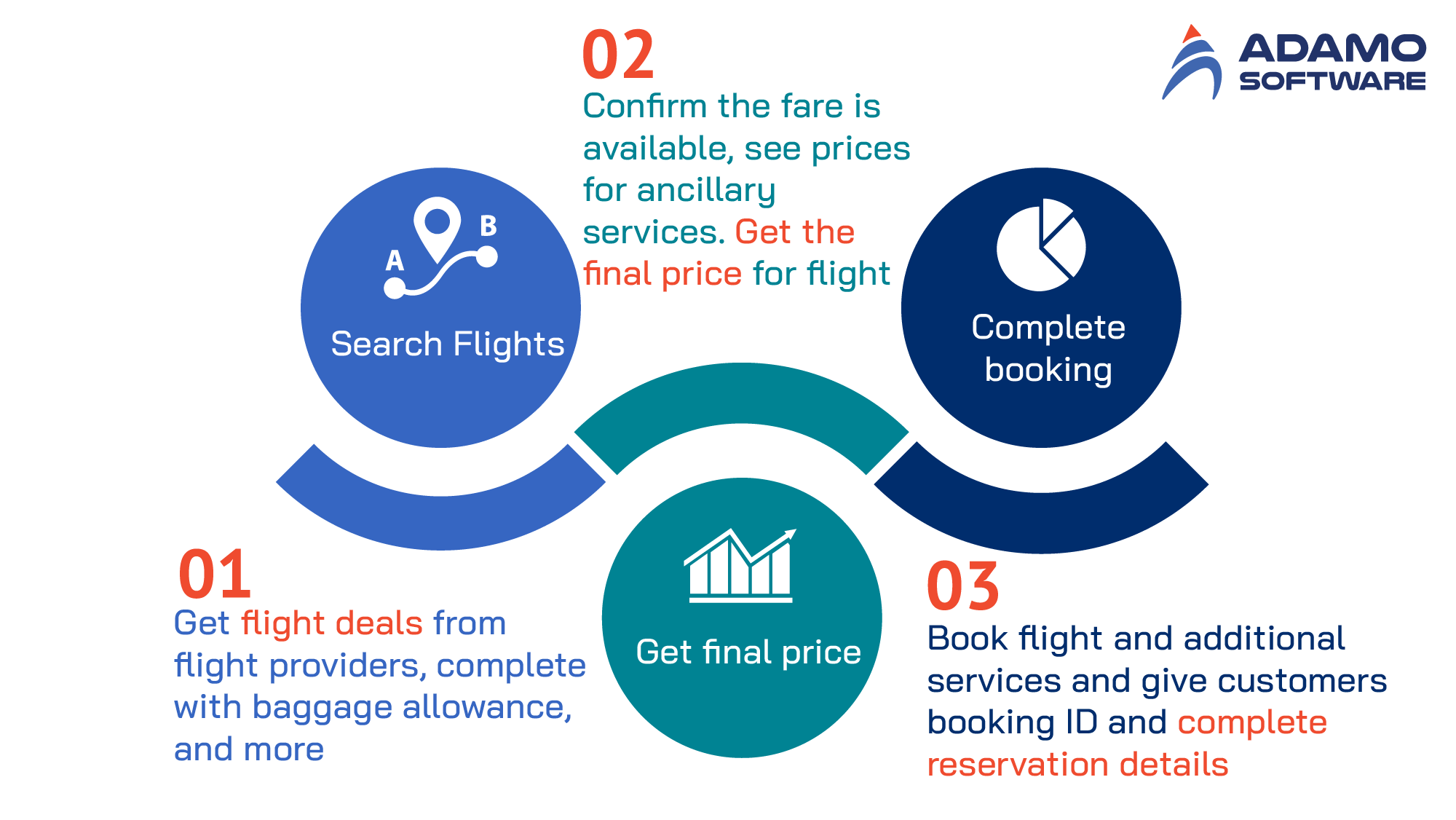What is Flight API? Use for Travel Itinerary Making Platforms

A flight API is a game-changer for digitally knowledgeable travelers in search of the best flight information. Check it out.
Flight API Integration enables travel agencies and online travel companies to connect their flight reservation systems to multiple flight suppliers. This integration enables travel companies to access real-time flight schedules, availability, prices, and other content from multiple airlines in a single location.
I. What is Flight API?
Flight API is a tool that extracts flight information data including pricing, location, schedule, and airport codes. With the aid of flight API, travel agencies, OTAs, and flight booking portal owners obtain flight-related information to provide their consumers with the best experience possible. This includes information regarding one-way, round-trip, global flight data, and specific countries.
In addition, flight API integration is the process of integrating Flight API with booking websites, booking portals, and OTAs to obtain real-time flight data in seconds.
If you are a travel agency or a developer creating a flight booking portal, Flight API is the most dependable API for providing global real-time flight data.
II. How does Flight API work?
1. Flight search engine
In the same way that online travel agents and review platforms provide prospective travelers with a plethora of hotel and dining options, the virtual domain comes alive with flight options.
The vastness of cyberspace can be overwhelming. Incorporating flight APIs into travel platforms simplifies the situation.
Prospective travelers can sift through this abundance of data and refine their queries based on specific origins, destinations, and travel dates, thereby transforming this massive amount of data into actionable results.
2. Flight tracking
Travel planners confront an ever-increasing demand to provide clients with real-time flight information, similar to how hoteliers sift through their competitors’ offerings to improve their own.
The challenge is not only to keep clients informed but also to provide them with the means to effectively strategize.
With Flight APIs available, travel planners can dispel the fog of ambiguity surrounding flight schedules.
3. Flight booking engine
Traditional in-person travel agency consultations are becoming vestiges of the past in an era where the digital landscape is filled with tools and technologies.
Flight APIs have revitalized this industry. By leveraging these APIs, travel platforms enable users to reserve their desired flights without multiple screens or superfluous redirects, ensuring a streamlined, user-friendly booking experience.
4. Flight data analysis
Data in its basic form can be intimidating. However, when properly harnessed, it becomes potent intelligence.
Consider how hoteliers deep-dive into reviews to decipher their competitors’ strengths and areas for development.
Likewise, flight APIs collect voluminous flight-related data. Travel platforms can sift through this data and deduce invaluable insights into flight pattern trends, such as identifying the airlines that consistently arrive on time and pinpointing airport peak hours.
This “smart data” derived from flight APIs has a significant impact on user experiences and strategic decisions.
III. Why flight API integration benefits the Travel Sector
1. Real-time flight data
Information is the foundation of effective decision-making in the world of travel planning, which is swiftly evolving.
Flight APIs emerge as a valuable instrument for real-time flight data, requiring travel planners to conduct in-depth analyses of which services resonate with customers.
It is not only about speed but also about unmatched accuracy.
With Flight APIs, planners have direct access to the most up-to-date flight data, ensuring that their suggestions and plans are never affected by last-minute changes.
It’s analogous to continuously updating a menu based on customer feedback; it’s always precise and pertinent.
2. Flexibility
Flight APIs provide travel platforms with an unparalleled advantage: adaptability. Platforms are no longer limited by a one-size-fits-all model.
After conducting a competitive analysis, they can refine their offerings and customize their services by leveraging these Flight APIs.
Whether emphasizing last-minute flights for impulsive travelers or providing intricate filters for meticulous planners, the platform can adapt to the traveler’s preferences.
3. Cost-effectiveness
The business world is not only about what you provide but also how you spend your money.
Why invest in complex data collection systems in the realm of flight data integration when flight APIs offer a streamlined, cost-effective alternative?
It is akin to intelligently investing in amenities that guests truly value, having observed their absence in competing hotels. By employing Flight APIs, travel platforms can reallocate funds to other innovations, knowing that they have secured flight data at a fraction of the potential cost.
IV. Types of flight booking API
1. Direct airline API
Provider of airline API or the airlines themselves offer direct airline API. The direct API integration of airline reservation systems eliminates the conventional distribution channel, allowing OTAs and TMCs to deal directly with airlines. In general, OTAs and TMCs integrate with corporations that can conduct direct business with airlines.
2. GDS API
The global distribution system provides the global content of flight inventory. In general, the inventory of all full-service carriers and some low-cost carriers affiliated with GDS is accessible. Currently, there are three major GDS API providers, which are as follows:
_ Amadeus
_ Galileo
_ Sabre
OTAs and TMCs can choose between Amadeus API Integration, Galileo API Integration, and Sabre API Integration for displaying the results, or they can combine them.
3. Third-party API
There can be many third-party API providers in a country. The integration of a direct airline and GDS is typically costly, so the incorporation of a third-party API is a preferable alternative. It is an excellent option for mid and small-size OTAs or TMCs.
4. Flight meta-search API
This is a novel travel industry trend-setter. A recently developed meta-search API integration gathers data from various OTAs and presents it to the consumer so they can compare the price and amenities offered by various portals to make a more informed choice. Travel agents who wish to offer this service can either develop their metasearch engine or acquire API from an existing metasearch engine.
You can read this blog to have an overview about what is travel API and how to choose the best one for your travel solutions.
V. Is there an API to get real-time flight data analysis?
The answer is YES. Real-time flight data tracking is an important feature in the flight search engine since it provides end-users with the most recent flight prices and other essential information. Check out the following Flight Search APIs offering real-time price data:

1. FlightAPI
FlightAPI’s intuitive and user-friendly interface is its defining characteristic. This API is excellent for tracking flight prices in real time as it provides rapid and accurate data. In addition, it excels in flight price comparison, providing exhaustive data that enables users to effectively compare flight prices across multiple airlines. In addition, it is inexpensive and offers 30k API calls for only $49, making it an ideal solution for platforms with a large user base that requires extensive pricing tracking and comparison capabilities.
2. Kiwi API
This API provides real-time flight, pricing, and routing information. It is possible to set up price alerts for specific itineraries, but it does not provide extensive coverage for every airline in the world.
3. Amadeus API
Amadeus API provides real-time flight pricing tracking that returns accurate and current fare data. It is capable of returning complex flight fares, making it suitable for various applications. Developers unfamiliar with flight search APIs may find the extensive features and sometimes complex documentation to be a bit of a challenge.
4. Sabre API
This is a potent tool that provides access to comprehensive flight data in real-time. It provides dynamic pricing, detailed flight information, and adaptable routing to accommodate various flight search needs. However, its extensive feature set may appear complicated to novices.
VI. Top-listed Flight API providers and more
1. Google Flight API
Google Flights is a flight search and scheduling engine that assists individuals in purchasing airline tickets from third-party vendors. Customers can compare options and prices and locate locations where they can swiftly purchase tickets. While this platform is accessible in 90 countries, enterprise partners are its primary audience.
Google’s APIs are accessible, well-documented, and used extensively across industries. Their API allows developers to search for and compare airline flight prices.
2. Skyscanner APIs
Skyscanner was established in 2003 to display all flight options in a single location. It has emerged from a flight search engine to the aviation industry champion. More than 100 million people rely on its app and website every month to assist them with flight planning. Moreover, it provides APIs for Skyscanner content distribution on global OTA platforms.
3. British Airways Flight API
British Airways is the largest airline in the United Kingdom, with approximately 80 destinations in Europe, North America, South America, Asia, Africa, and Australia. British Airways APIs are accessible to developers of all skill levels. British Airlines’ parent company, International Airlines Group, offers access to Flight Deals and Lowest Price APIs on its website.
4. Expedia API
The robust structure of the Expedia Affiliate Network (EAN) APIs enables rapid responses and instantaneous retrieval of data from multiple sources to provide real-time updates on rates and availability on your booking platform.
EAN APIs are used to schedule flights, hotels, and automobiles. The well-designed framework of Expedia facilitates over 200 flight booking websites in 75 countries and over 150 mobile websites. Expedia API Integration links any online booking service to 140,000 hotels in 245 countries. It has a significant consumer base in the US, Canada, Mexico, India, and the United Arab Emirates.
5. TBO APIs
TBO Holidays is a prominent flight aggregator, partnering with 70,000 flight agencies in over 100 countries and utilizing TBO’s award-winning technology to enable online booking of global flight content. It offers flights, lodging, excursions, automobiles, transfers, and sightseeing.
6. Mystifly API
Mystify is one of the most well-known flight ticketing APIs for all types of airlines, including low-cost and charter airlines. It is an excellent option for anyone seeking to integrate flight registration software with their website or mobile application.
7. EaseMyTrip API
The foremost B2B & B2C online travel portal company in India, EaseMyTrip, offers flight booking API. With the EaseMyTrip Flight API, travel agents have access to a vast inventory of global flights from reputable air flight suppliers. In this manner, they provide services to consumers.
8. TripAdvisor API
TripAdvisor is the world’s greatest travel website. It has the largest selection of travel listings globally, with 702 million reviews and opinions covering the world’s largest range of travel listings. Developers can obtain dynamic access to current rating data and select travel websites. The architecture of this API is RESTful, and it serves a singular purpose. It accepts JSON responses along with JSONP, URI Query String/CRUD requests, and JSONP responses. The TripAdvisor API employs a key-based authentication scheme.
VII. How do we integrate Flight API into the client’s flight websites?
In the flight API integration, two parties are involved. Therefore, how you establish the connection will hinge on your goals and the API you choose.
Start with you. What is your flight’s website address? Do you want to facilitate booking or provide only flight-related information to your users? Are you targeting specific territories or do you intend to provide service globally? Budget and resource limitations are not the least of our concerns. Based on these details, you will select an API with the appropriate capabilities and coverage.
Whether you choose to integrate with a GDS, a tech service provider, an online travel agency (OTA), or a metasearch, the integration process will vary. For example, GDS will provide you with pools of raw airline data, whereas OTAs and metasearch have it organized in their unique manner.
Once you have identified the platform from which you wish to extract data, review its API documentation and, if available, experiment with its test version. You will need an HTTP client to perform API calls.
Having determined that your website will benefit from using this API, obtain the API access key and determine whether the provider offers integration assistance or a pre-built API connection. If not, you may involve an outside integrator. Before the release, ensure that you have independently validated the API responses.
VIII. Integrate Your Flight API with Adamo
As a premier software development company in Vietnam, Adamo Software has lots of experience in creating mobile apps in the travel and hospitality industry. With our skillful developers, Adamo creates a lucrative flight booking engine with API integration.
We help travel agents and tourism service providers to transform their business ideas and explore new business opportunities. If you are looking for travel and hospitality software development, contact us for more details.











